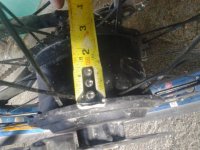Sounds like you have some hours and days of searching and reading to do. (there is a LOT of material to go thru).devlin016 said:I cant do Ferrofluid as those fixes dont seem to be legit and look hackerd to me. someone needs to develop a hub motor with forced air cooling or something with a vent and a screen or filter or something.. I know it wouldnt be water proof but id choose the cooling over water proofing....just make sure its a good screen or filter to keep dust debry from getting in the fans.
There are a number of threads that discuss the merits of various cooling methods, including at least one by Justin_LE specifically for testing methods of heating and cooling of hubmotors, with actual test data.
There is also the http://ebikes.ca/simulator, which for motors that have thermal test data, will *show* you what happens under whatever conditions you setup in the simulator.
I'd also recommend reading the "motor power ratings" page on ebikes.ca, as it will help explain some of what others have been trying to point out on here.
Learning what's already been done, and then seeing how it works in the simulator, may save you some time and money in reproducing all of this on your own.
FWIW, if you're really a perfectionist, I would recommend listening to what people have been telling you here, as you may be able to make a "perfect" system for your needs and usage scenario by doing that. But by resisting concepts discussed here, you may not be able to make something that will really do what you want to do, without overstressing the parts you use and shortening their lifespan, at best. (and at worst, not do what you want at all).
Unfortunatley most of the "perfectionists" I've met (including the one I see in the mirror) are not really perfectionists...they're just stubborn.



